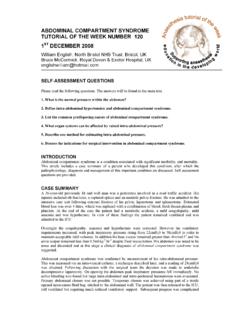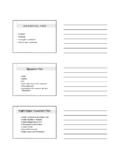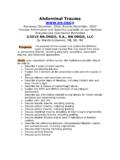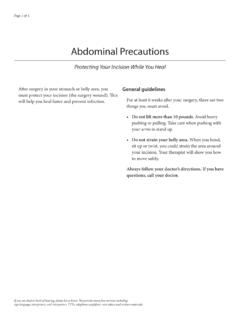Transcription of Christopher Cheung APPROACH TO PEDIATRIC …
1 Christopher CheungAPPROACH TO PEDIATRIC abdominal PAINI ndexGeneral Presentation .. 1 Table 1 Common Causes of abdominal Pain .. 2 Questions to Ask .. 2 Table 2 Associated Symptoms for abdominal Pain .. 3 Common Differential Diagnoses and Potential Complications 4 Table 3 Common Differential Diagnosis for abdominal Pain.
2 4 Physical Exam and Investigations .. 4 PHYSICAL EXAM .. 4 Table 4 Findings on Physical Exam for Common Differential Diagnoses .. 5 LABORATORY INVESTIGATIONS .. 5 Table 5 Laboratory Investigations for Common Differential Diagnoses.
3 5 Supplementary Information .. 6 Uncommon Differential Diagnoses and Potential Complications .. 6 Table 6 Uncommon Differential Diagnosis for abdominal Pain .. 6 Table 7 Findings on Physical Exam for Uncommon Differential Diagnoses .. 7 References.
4 7 Acknowledgements .. 8 General PresentationBACKGROUNDA bdominal pain in a child is one of the most common presentations with both trivial and life-threatening etiologies, ranging from functional pain to acute appendicitis. The majority of PEDIATRIC abdominal complaints are relatively benign ( constipation), but it is important to pick up on the cardinal signs that might suggest a more serious underlying abdominal pain in children is also a challenging task. Conditions vary amongst age groups (ie. volvulus in neonates, intussusception in toddlers) and trying to thoroughly evaluate a child in pain can make the process all the more challenging.
5 BASIC ANATOMY AND PHYSIOLOGYWhen taking a history and examining a child with abdominal pain, consider all the organs in the abdominal area. Pathologies of the lower lung ( pneumonia) can often be interpreted as abdominal pain; similarly, genitourinary pathology ( testicular torsion) can be as well. A sharp stabbing pain may suggest somatic involvement this type of sensation is usually well localized; while dull, non-specific, throbbing pain suggests visceral involvement that is difficult to localize. Remember, the differential diagnosis of a child varies depending on their age group. (Table 1)Table 1 Common Causes of abdominal Pain NewbornIntestinal obstruction (ie.)
6 Volvulus, Hirshsprung, pyloric stenosis)Peritonitis ( necrotizing enterocolitis, GI perforation)HerniaGastroesophageal RefluxTrauma ( during birth)Infant (<2 years)ConstipationToxin ingestionAcute gastroenteritisTraumaHernia, volvulus, intussusceptionInfantile dyscheziaColicRespiratory illnessChildren (2 18 years)Acute gastroenteritisUrinary tract infection/ PyelonephritisConstipationToxin ingestion, food poisoningIntestinal obstructionTraumaTesticular torsionHenoch-Schnolein PurpuraRespiratory illness, pneumonia,Appendicitis, pancreatitis, cholecystitisMesenteric adenitisAdolescents (12 18 years)Trauma Toxin ingestion, food poisoningDysmenorrheaPregnancy ( ectopic)Pelvic inflammatory diseaseTesticular torsionOvarian torsion/cystsGastroenteritisConstipation PRESENTATION AND EMERGENT CONSIDERATIONSA cute pain lasts several hours to days while chronic pain can last from days to weeks to months.
7 In a child presenting with abdominal pain, it is important to identify any emergent concerns and reach a timely diagnosis. Red flag signs include: Bilious vomiting Bloody stool or emesis Night time waking with abdominal pain Hemodynamic instability Weight lossQuestions to AskHISTORY PQRSTAAA: oPlace/Location: identify the specific location of the pain, have child use one finger to locate her pain. oQuality: pain can be a sharp stabbing pain ( trauma) or diffuse, poorly, localized pain ( chronic or visceral pain) oRadiation: pain can radiate from its point of origin in any direction oSeverity: degree of pain on a scale of 10 oTiming/Onset: onset of the pain, duration of pain, course during the day, does it wake them at night, and the frequency of episodes oAlleviating Factors: anything that reduces the pain body position, movements (or lack thereof), Factors: anything that increases the pain body position, movements, relation to food Symptoms.
8 Can include hematemesis, vomiting, nausea, hematochezia, melena, diarrhea, fever, and weight loss. (Relevant findings: See Table 2) Ask about bowel movement patterns and stool quality (size, hard/soft, odour). Ask about ingestion of toxin or foreign object; accidental or non-accidental trauma Ask about dietary history: in young children, too much milk can lead to constipation. Ask about past medical history and medical fibrosis predisposes to bifida/cerebral palsy/developmental delay predisposes to cell disease predisposes to splenic respiratory tract infections suggest mesenteric adenitis. Ask about sexual history screen for STIoFemales: don t forget about menstrual cycles (regularity, amount of bleeding, relation to abdominal pain) Ask about family medical history, especially inflammatory bowel diseas.
9 Ask about travel history, social and psychiatric (potential stressors) history. Table 2 Associated Symptoms for abdominal Pain Associated SymptomRelevanceDiarrheaGastroenteritis, Protein losing enteropathyBloody stoolUGIB/LGIB, Ulcerative colitis, necrotizing enterocolitis, dysentery, constipationHematemesisUGID, Peptic Ulcer Disease, GastritisBilious emesisSmall bowel obstructionJaundiceHepatitis or Biliary Tree obstructionJoint pain/swellingIBD, HSPSkin LesionsIBD, HSP, Liver diseaseTesticular painTesticular torsion Dysuria/polyuria/hematuriaUrinary tract infection/PyelonephritisVaginal/Penile dischargeSTID ysmenorrheaEndometriosisShortness of breathPneumonia or empyemaCommon Differential Diagnoses and Potential ComplicationsTable 3 Common Differential Diagnosis for abdominal PainMedical ConditionRelevant Findings and Potential ComplicationsGastrointestinalConstipatio nInfrequent bowel evacuations, difficult or painful defecation, can see blood in stool from anal fissures, low fibre diet, high milk consumption (>2-3 cups per day)
10 Acute appendicitisRight lower quadrant pain with fever, anorexia, nausea, vomiting, can rupture and lead to sepsisGastroenteritisVomiting and diarrhea with or without fever and nausea, can have bacterial or viral etiologiesIrritable bowel syndromeChange in stool frequency, bloating, abdominal distension, may be associated with certain foodsTraumaHistory and signs of bruisingUlcerative colitisBloody and/or chronic diarrhea, crampy lower abdominal pain, anorexia, weight loss, fever, fecal urgency, can develop to toxic megacolonCrohn s diseaseIntermittent diarrhea, weight loss, crampy right lower quadrant pain, anorexia, weight loss, fatigueCeliac DiseaseAbdominal pain, bloating, growth failure, gluten insensitivityInflammatory Bowel DiseaseAssociated with diarrhea, bloody stools, weight loss, can lead to significant growth failure if tract infectionDysuria, polyuria, hematuria, can progress to pyelonephritisPrimary dysmenorrheaHistory of menstrual periods and regularity, consider sexual historyPulmonaryPneumonia and EmpyemaConsider respiratory history, past medical history and recurrent respiratory tract infectionsPhysical Exam and InvestigationsPHYSICAL EXAMABCs; vitals; and growth parameters (is there evidence of failure to thrive).




